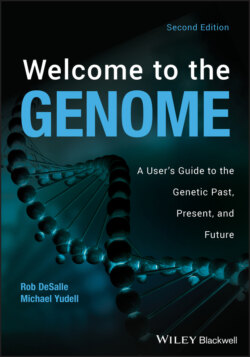Читать книгу Welcome to the Genome - Michael Yudell - Страница 21
2 The Building Blocks of Gene Sequencing
ОглавлениеIn the 1940s the Nobel Prize‐winning physicist Erwin Schrodinger inspired a generation of scientists to study genes. Known primarily for his work in quantum mechanics, Schrodinger spent World War II in exile in Dublin, where in February 1943 he gave a pioneering series of lectures at Trinity College on the importance of understanding the physical laws that govern heredity. These groundbreaking talks, published a year later as a slim volume entitled What is Life?, anticipated the importance of DNA just as scientists began to establish the nature of what Schrodinger called “the most essential part of a living cell—the chromosome fibre.” (1) With no formal training in the biological sciences, Schrodinger came to genetics with what he called “a naïve physicist’s ideas about organisms.” (2) Despite this limitation, by combining a physicist’s sense of the need for order in the natural world with a sophisticated understanding of contemporary currents in the biological sciences, Schrodinger was able to articulate a prescient and stirring vision of what was to come in molecular biology.
Schrodinger’s call to biologists posed the central question of What is Life?:
How can the events in space and time which take place within the spatial boundary of a living organism be accounted for by physics and chemistry? (3)
The almost 90‐page answer to this question, considered by many to be one of the masterpieces of scientific literature, speculated on how hereditary material survives in conditions outside of the known boundaries of physics to pass on genetic information generation after generation. He suggested that the answer lay in the chromosome fiber, which, compared with the “rather plain and dull” material of inanimate nature, was more like a “masterpiece of embroidery,” “an elaborate, coherent, meaningful design traced by the great master.” (4) This, the most basic idea in What is Life?, influenced the young generation of biologists in the 1940s and early 1950s to follow Schrodinger’s clarion call and search for the rules that underlie genetic matter. Schrodinger’s influence is unmistakable. After reading What is Life? James Watson remembered that he “became polarized towards finding out the secret of the gene.” Francis Crick, Watson’s co‐discoverer of the structure of DNA, recalled the impact of the book, remembering that it “suggested that biological problems could be thought about in physical terms—and thus it gave the impression that exciting things in this field were not far off.” (5)
Schrodinger’s reduction of life to the laws of physics and chemistry need not be read as a deterministic view of the primacy of genetic heredity over the other factors that determine an individual (i.e., the components of a person’s environment). After all, the question of his book is “What is life?” and not “What makes us human?” or “What is the meaning of life?” Instead, Schrodinger was after something much more basic—the substances and rules that determine genetic heredity—that from a physicist’s viewpoint was essential to understanding life. The discoveries discussed in this chapter reflect Schrodinger’s conviction that the substance of life can be reduced to interplay between physics and chemistry. Yet, although these discoveries illustrate the mechanistic nature of genetic heredity, they cannot paint a complete picture of why we are the way we are. “The answer to What is Life?” the evolutionary biologist Stephen Jay Gould reminds us, “requires attention to more things on earth than are dreamed of in Schrodinger’s philosophy.” (6)
This chapter examines some of the essential components of the gene sequencing puzzle (through the twentieth century) and of the growing general understanding of the mechanisms of heredity. Today we can look back on these discoveries and see how they are like stations along an assembly line, making up separate pieces that are all essential to the overall product of gene sequencing. In Chapter 3 we will see how all of these technologies came together to give us the technology that sequenced the human genome.
